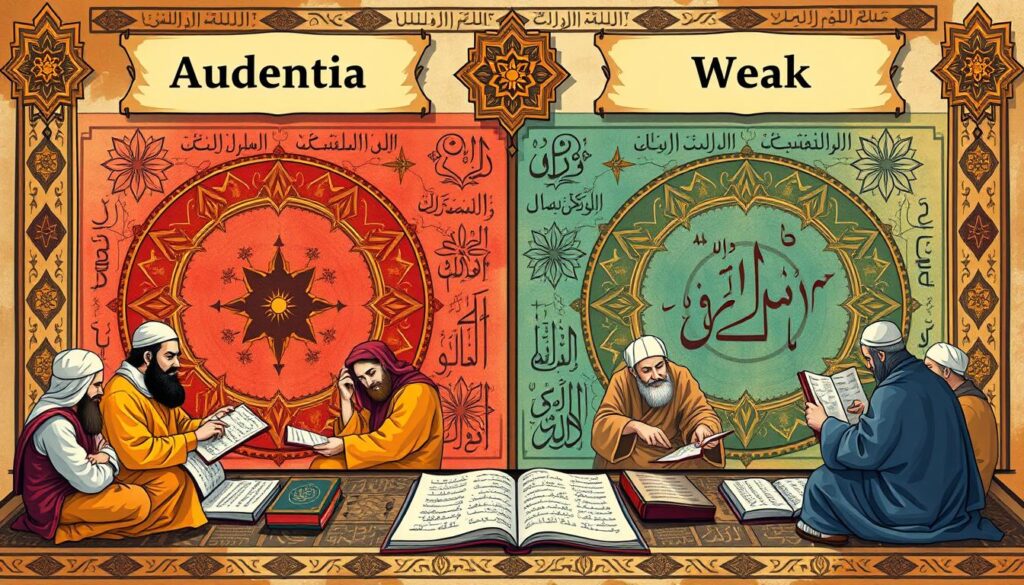At Umar Khan Charity Organization, we’re dedicated to giving our community the right info. Knowing the difference between real and weak Hadith is key. A real Hadith must pass 6 tests about its chain of transmission. If it does, it’s considered authentic; if not, it’s weak. This is why knowing the difference is so important.
We’re going to look into what makes a Hadith real or weak. We’ll also see why knowing this is important in Islamic tradition.
Key Takeaways
- Understanding the difference between authentic and weak Hadith is key for accurate info.
- Authentic Hadith must meet 6 specific criteria about the chain of transmission.
- Knowing how to classify Hadith is vital for figuring out its authenticity.
- Weak Hadith can have serious implications and go against proven historical facts.
- Early Muslim scholars used the isnad system to check narrators and find reliable sources.
- Understanding Hadith authenticity and classification is essential in Islamic tradition and scholarship.
- We want to help our readers make smart choices about the Hadith they come across.
Understanding Hadith: An Introduction
We think it’s key to understand Hadith to see its role in guiding Muslim beliefs and practices. As we dive into Hadith, we’ll look at its definition, types, and why it’s important in Islamic tradition. Learning about Hadith is rewarding, and we hope to encourage our readers to explore this important Islamic tradition.
Definition of Hadith
Hadith is a vital part of Islamic tradition, guiding Muslims alongside the Quran. There are different types of Hadith, like Sahih, Hasan, and
Importance in Islamic Tradition
Hadith is key in guiding Muslim beliefs and practices. The Criteria for Hadith authenticity help decide if a Hadith is reliable. Important factors include:
- Hadith classification
- Sahih vs. Da’if Hadith
- Criteria for Hadith authenticity
Understanding these factors helps us see the value of Hadith in Islamic tradition. It also helps us make informed choices about our beliefs and practices.
The Categories of Hadith: An Overview
Understanding the different types of Hadith is key. It helps us know if Islamic teachings are true. Grading Hadith is important to check if they are reliable. We look at who told the story, their trustworthiness, and the story itself.
Hadith authenticity is a big deal in Islam. It makes sure the Prophet Muhammad’s teachings are passed on right. If Hadith are weak, we might get things wrong. That’s why we sort them into Sahih, Hasan, and Da’if.
Authentic Hadith Explained
Authentic Hadith, or Sahih, have a solid chain of trustworthy narrators. They are free from any mistakes. These Hadith are the most reliable and guide Islamic law.
Weak Hadith Explained
Weak Hadith, or Da’if, have issues with their narrators or contain errors. They might not be good for making laws, but they can offer insights into the Prophet’s teachings.
The Role of Classification
Sorting Hadith into Sahih, Hasan, and Da’if is vital. It helps us see if they are trustworthy. We check the narrator’s chain, their trustworthiness, and the Hadith’s content. Knowing these categories helps us value Hadith grading and authenticity in Islam.
| Category | Description |
|---|---|
| Sahih | Authentic Hadith with a continuous chain of reliable narrators |
| Hasan | Good Hadith with a reliable chain of narrators, but with some flaws |
| Da’if | Weak Hadith with a lack of reliable narrators or containing flaws |

Criteria for Authenticating Hadith
We want to help our readers understand how Hadith is verified. It’s all about a strong chain of transmission and the text’s integrity. This process is always ongoing, with a focus on reviewing old criteria carefully.
The Criteria for Hadith authenticity focus on the chain of transmission (isnad) and the text (matn). These are key to figuring out the Authenticity of Hadith in Islam. The Hadith grading checks if the narrators are trustworthy and if the text aligns with Islamic beliefs.
Chain of Transmission (Isnad)
The chain of transmission is vital for verifying Hadith. It’s important to check the narrators’ reliability. Here are some key points to look at:
- Reliability of the narrators
- Consistency of the text with established beliefs
- Absence of any contradictions or inconsistencies
Textual Integrity (Matn)
The text must also meet certain standards for authenticity. This includes:
- Consistency with the Quran and other established Hadith
- Absence of any contradictions or inconsistencies
- Clarity and coherence of the text
Understanding these criteria helps us assess Hadith reliability. It guides us in making choices based on Islamic teachings. The Criteria for Hadith authenticity are vital for keeping Islamic tradition strong and true to the Prophet’s teachings.
Characteristics of Authentic Hadith
Understanding the traits of authentic Hadith is key to keeping Islamic teachings true. We must learn to tell the difference between Sahih (authentic) and Da’if (weak) Hadith. Knowing how to classify Hadith helps us trust the right ones.
A reliable chain of narrators is essential for authentic Hadith. We need to check each narrator’s trustworthiness. A Hadith is Sahih if it has a solid chain and follows Islamic teachings. A Da’if Hadith has doubts about its narrators. For more on Hadith classification, check out this resource.
Reliability of Narrators
The trustworthiness of narrators is critical in Hadith classification. We should look at a few things when judging a narrator:
- Strong memory and integrity
- Continuous chain of transmission (Mutassil)
- Conformity to established Islamic principles
Consistency with Established Beliefs
Authentic Hadith must match Islamic beliefs and principles. We should check if the Hadith agrees with the Quran and other trusted Hadith. By knowing what makes a Hadith authentic, we can choose wisely which ones to follow.

Characteristics of Weak Hadith
Understanding Weak Hadith is key in hadith sciences. It affects how we grade and authenticate hadiths. Weak Hadith often comes from problems in the chain of narration. This can include a missing link or an unreliable narrator.
Islamic scholars say a hadith is weak if it lacks authenticity. This can happen for many reasons. For example, if a narrator is not trustworthy or if the hadith goes against established beliefs. In these cases, the hadith is not reliable for Islamic practices or decisions.
Weak hadith examples include those with incomplete or uncertain chains. For instance, a hadith narrated by one person without backup evidence is weak. Also, hadiths that contradict the Quran or other established hadiths are weak.
It’s important to carefully evaluate hadiths for authenticity and reliability. This ensures our understanding of Islam is based on solid, authentic sources. By doing this, we avoid weak or fabricated hadiths.
| Criteria | Description |
|---|---|
| Chain of Narration | A continuous chain of reliable narrators |
| Textual Integrity | Consistency with established beliefs and the Quran |
| Hadith Grading | Evaluation of the hadith’s authenticity and reliability |
The Impact of Weak Hadith on Islamic Jurisprudence
We understand the importance of Hadith classification in Islam. It helps us know if a Hadith is true or not. The difference between Sahih and Da’if Hadith is key to trust in Islamic teachings.
There’s a debate on using weak Hadith. Scholars have different views. Some say it’s not allowed, while others think it’s okay under certain conditions. Scholarly opinions vary widely.
- Total prohibition on using weak Hadith for any rulings or fada’il.
- Permissible to use weak Hadith in matters of jurisprudence, fada’il, and manaqib under specific requirements.
- Permissible only in matters relating to fada’il, manaqib, and targhib wa al-tarhib, excluding jurisprudence and ‘aqidah, with certain conditions.

Fabricated Hadiths started spreading after the death of the third Caliph, ‘Uthman Ibn al-Affan. The acceptance of these false Hadiths grew during the fight between Ali Ibn Abi Talib and Mu’awiyah Ibn Abi Suffiyan.
Misinterpretations and Misuse
Weak Hadith can be misused, leading to wrong practices and a wrong understanding of Islam.
The Importance of Scholarly Opinion
Experts’ opinions are key in understanding Hadith. They help us use them right. By listening to respected scholars, we avoid problems with weak Hadith and keep Islamic law strong.
| Scholar | Opinion on Weak Hadith |
|---|---|
| Ahmad bin Hanbal | Permissible to use weak Hadith in certain circumstances |
| Yahya b. Ma‘in | Opposes the use of weak Hadith |
| Al-Bukhari | Emphasizes the importance of authentic Hadith |
How Scholars Differentiate Between Authentic and Weak Hadith
Distinguishing between authentic and weak Hadith is key in Islamic scholarship. Scholars use a detailed method to check the chain of transmission and the text. This helps them figure out if a Hadith is true or not.
When grading Hadith, scholars look at who narrated it and if it matches Islamic beliefs. This careful method helps sort Hadith into levels of trustworthiness. These levels include sahih (authentic), hasan (good), da`if (weak), munkar (denounced), and mawdu` (fabricated).
The Science of Hadith Criticism
Scholars have created a science to check Hadith authenticity. They study the narrators’ backgrounds, the chains of transmission, and the text’s integrity. This way, they can tell which Hadith are reliable and which are not.
| Category | Description |
|---|---|
| Sahih (Authentic) | Meets the highest standards of authenticity |
| Hasan (Good) | Meets most standards of authenticity, but with some minor issues |
| Da`if (Weak) | Falls short of the standards of authenticity due to significant issues |
Understanding how to judge Hadith authenticity is vital. Scholars use these principles to tell real Hadith from weak ones. This ensures Islamic teachings and practices remain true and reliable.
Practical Applications: Using Hadith in Daily Life
Applying authentic Hadith in our daily lives is key. Understanding Hadith classification is essential. Knowing the difference between Sahih and Da’if Hadith helps us make better choices. This ensures our actions and beliefs are based on reliable sources.
How to Incorporate Authentic Hadith
To include authentic Hadith in our daily routine, we should study Sahih Bukhari and Sahih Muslim. These collections help us understand Islamic principles and practices. By focusing on Sahih Hadith, we learn from the Prophet’s teachings and apply them to our lives.
Avoiding Weak Hadith in Decision-Making
It’s important to avoid weak Hadith to keep our beliefs and actions pure. We should be careful of Da’if Hadith, as it can lead to wrong decisions. By knowing the criteria for Hadith authenticity and being mindful of sources, we make choices that align with Islamic values.
As we try to apply Hadith in our lives, remember the importance of classification. Distinguishing between Sahih and Da’if Hadith is critical. This helps us deepen our understanding of Islamic teachings and live a more authentic faith.
Online Resources for Researching Hadith
We know how vital it is to find trustworthy online sources for Hadith research. That’s why we’ve put together a list of top databases and websites. It’s key to look at the Hadith grading and the Authenticity of Hadith in Islam. Also, knowing about Weak Hadith in hadith sciences is important.
Start by checking out the Umar Khan Charity website for prayer times and Islamic resources. You can also look into online databases like the Hadith Database or the Islamic Knowledge Database. These offer a huge collection of Hadith and Islamic texts.
- Authority and credibility of the source
- Accuracy and reliability of the information
- Relevance to your research topic
By following these tips and using reliable online resources, you can make sure your Hadith research is correct and trustworthy.
Conclusion: Navigating Hadith with Knowledge and Care
As we conclude our exploration ofauthentic vs. weak Hadith, it’s clear that understanding these texts is a lifelong journey. It demands a deep commitment to learning and critical thinking. Theclassification of Hadithinto types likesahih (authentic), hasan (good), and da’if (weak)is key to preserving the Prophet’s teachings.
Early Islamic scholars worked hard to create a system forevaluating Hadith authenticity. They looked at the trustworthiness of narrators and the reports’ integrity. It’s vital to stay alert, seeking reliable sources and questioning everything. This way, we can use Hadith correctly, staying true to Islamic tradition.
The study of Hadith is a never-ending adventure. We urge our readers to dive into it with excitement. By learning to tell the real from the fake, we grow to appreciate the Prophet’s teachings more. Let’s work together to keep Hadith’s integrity and apply its wisdom in a way that honors our faith.





